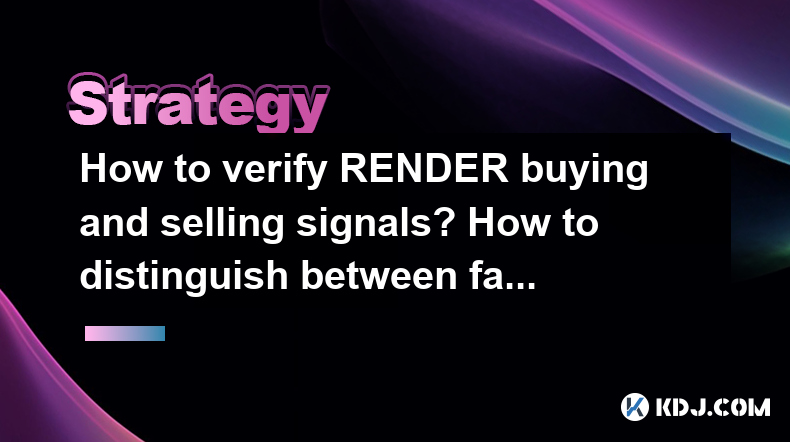-
 bitcoin
bitcoin $110918.433029 USD
-1.69% -
 ethereum
ethereum $3996.872473 USD
-2.43% -
 tether
tether $1.000594 USD
0.00% -
 bnb
bnb $1178.871834 USD
-2.38% -
 xrp
xrp $2.413973 USD
-3.47% -
 solana
solana $194.341461 USD
-4.24% -
 usd-coin
usd-coin $0.999963 USD
-0.03% -
 tron
tron $0.320092 USD
0.92% -
 dogecoin
dogecoin $0.196919 USD
-3.42% -
 cardano
cardano $0.669585 USD
-3.63% -
 hyperliquid
hyperliquid $37.485952 USD
-3.58% -
 ethena-usde
ethena-usde $1.000026 USD
-0.02% -
 chainlink
chainlink $18.018220 USD
-5.13% -
 bitcoin-cash
bitcoin-cash $523.879267 USD
-2.41% -
 stellar
stellar $0.324655 USD
-3.67%
How to verify RENDER buying and selling signals? How to distinguish between false breakthroughs and true breakthroughs?
To verify RENDER buying signals, look for price breakouts above resistance, high volume, and bullish indicators like RSI above 50 and MACD crossovers.
May 01, 2025 at 08:42 pm

In the world of cryptocurrency trading, understanding and verifying buying and selling signals for tokens like RENDER is crucial for making informed investment decisions. Additionally, distinguishing between false breakthroughs and true breakthroughs can significantly impact your trading strategy. This article will delve into these topics, providing detailed guidance on how to verify RENDER buying and selling signals and how to differentiate between false and true breakthroughs.
Understanding RENDER Buying and Selling Signals
RENDER, like many other cryptocurrencies, generates buying and selling signals through various technical analysis tools and indicators. These signals help traders decide when to enter or exit a position. Common tools used to generate these signals include moving averages, Relative Strength Index (RSI), and Bollinger Bands.
To verify a buying signal for RENDER, you should look for several confirmatory indicators:
- Price Action: A buying signal is often confirmed when the price of RENDER breaks above a significant resistance level. This could be a previous high or a level identified by technical analysis.
- Volume: High trading volume accompanying the price breakout suggests strong market interest and validates the buying signal.
- Technical Indicators: Look for bullish signals from indicators like the RSI moving above 50 or the MACD line crossing above the signal line.
For a selling signal, the process is similar but in reverse:
- Price Action: A selling signal is confirmed when the price of RENDER breaks below a significant support level.
- Volume: High volume during a price breakdown indicates strong selling pressure and validates the selling signal.
- Technical Indicators: Bearish signals from indicators like the RSI moving below 50 or the MACD line crossing below the signal line can confirm a selling signal.
Tools for Verifying RENDER Signals
Several tools can aid in verifying RENDER buying and selling signals:
- TradingView: This platform offers a wide range of charting tools and indicators that can help you analyze RENDER price movements and confirm signals.
- Coinigy: Another comprehensive platform that provides real-time data and technical analysis tools for cryptocurrencies, including RENDER.
- CryptoWatch: This tool allows you to monitor RENDER price movements and set up alerts for specific price levels or technical indicators.
To use these tools effectively, follow these steps:
- Select the Platform: Choose a platform like TradingView, Coinigy, or CryptoWatch based on your preferences and needs.
- Set Up Charts: Add RENDER to your charting interface and select the time frame you want to analyze (e.g., 1-hour, 4-hour, daily).
- Apply Indicators: Add relevant technical indicators such as moving averages, RSI, and MACD to your chart.
- Analyze Signals: Look for the confirmatory signals mentioned earlier, such as price breakouts, volume spikes, and indicator movements.
Distinguishing Between False Breakthroughs and True Breakthroughs
A breakthrough in the context of RENDER trading refers to the price moving decisively above a resistance level (bullish breakthrough) or below a support level (bearish breakthrough). However, not all breakthroughs are reliable; some are false, leading to potential losses if acted upon hastily.
To distinguish between false breakthroughs and true breakthroughs, consider the following factors:
- Price Retracement: After a breakthrough, observe whether the price quickly retraces back to the previous level. A false breakthrough often sees the price returning to the support or resistance level shortly after breaking it.
- Volume: True breakthroughs are typically accompanied by high trading volume, indicating strong market conviction. False breakthroughs may occur on low volume, suggesting weak market interest.
- Follow-Through: A true breakthrough will often see the price continue in the direction of the breakout. If the price fails to sustain the move and reverses, it may be a false breakthrough.
Identifying False Breakthroughs in RENDER
To identify a false breakthrough in RENDER, follow these steps:
- Monitor Price Action: After a breakthrough, keep a close eye on the price movement. If the price quickly returns to the previous level, it may be a false breakthrough.
- Check Volume: Compare the volume during the breakthrough to the average volume. If the volume is unusually low, it may indicate a false breakthrough.
- Analyze Indicators: Use technical indicators like the RSI and MACD to see if they confirm the breakthrough. If the indicators do not support the price movement, it may be a false signal.
Identifying True Breakthroughs in RENDER
To identify a true breakthrough in RENDER, follow these steps:
- Confirm Price Movement: Ensure that the price continues to move in the direction of the breakthrough without significant retracement.
- Verify Volume: High volume during and after the breakthrough is a strong indicator of a true breakthrough.
- Check Indicators: Confirm that technical indicators support the breakthrough. For instance, if the RSI is trending upwards and the MACD shows a bullish crossover, it supports a true bullish breakthrough.
Practical Example of Verifying RENDER Signals
Let's walk through a practical example of verifying a buying signal for RENDER:
- Price Action: Suppose RENDER breaks above a resistance level at $10.
- Volume: Check the trading volume during this breakout. If the volume is significantly higher than the average, it supports the buying signal.
- Technical Indicators: Look at the RSI and MACD. If the RSI is above 50 and the MACD shows a bullish crossover, these indicators confirm the buying signal.
For a selling signal, the process would be similar but in reverse:
- Price Action: Suppose RENDER breaks below a support level at $8.
- Volume: Verify that the volume during this breakdown is high, indicating strong selling pressure.
- Technical Indicators: Check if the RSI is below 50 and the MACD shows a bearish crossover, confirming the selling signal.
Frequently Asked Questions
Q: Can fundamental analysis help in verifying RENDER buying and selling signals?A: While technical analysis is primarily used for verifying buying and selling signals, fundamental analysis can provide additional context. For instance, positive developments in the RENDER project, such as partnerships or technological advancements, can support a buying signal. Conversely, negative news or regulatory issues can reinforce a selling signal.
Q: How often should I check for RENDER signals?A: The frequency of checking for RENDER signals depends on your trading strategy. Day traders may need to monitor signals multiple times a day, while swing traders might check signals on a daily or weekly basis. It's important to align your signal-checking frequency with your trading time frame.
Q: Are there any automated tools for verifying RENDER signals?A: Yes, there are automated tools and trading bots that can help verify RENDER signals. Platforms like 3Commas and Cryptohopper offer automated trading strategies based on technical indicators. However, it's crucial to thoroughly test and monitor these tools to ensure they align with your trading goals.
Q: How can I improve my skills in distinguishing between false and true breakthroughs?A: Improving your skills in distinguishing between false and true breakthroughs requires practice and continuous learning. Engage in backtesting historical data to see how different breakthroughs played out. Additionally, staying updated with market news and participating in trading communities can provide valuable insights and feedback on your analysis.
Disclaimer:info@kdj.com
The information provided is not trading advice. kdj.com does not assume any responsibility for any investments made based on the information provided in this article. Cryptocurrencies are highly volatile and it is highly recommended that you invest with caution after thorough research!
If you believe that the content used on this website infringes your copyright, please contact us immediately (info@kdj.com) and we will delete it promptly.
- Larry Fink and BlackRock: Tokenizing All the Assets, Baby!
- 2025-10-16 11:05:12
- Meme Coin Mania: MoonBull, FLOKI, and SHIB – What's the Buzz?
- 2025-10-16 09:10:00
- Pepeto's Presale Success: Riding the Crypto Bull Run Wave
- 2025-10-16 08:30:01
- Affordable GPUs for Gamers: A 2025 Deep Dive
- 2025-10-16 10:25:12
- Coinbase, BNB, and Token Listings: A New Era?
- 2025-10-16 09:25:16
- Secure Enclave, Flow, and Launch: What's the Buzz?
- 2025-10-16 08:30:01
Related knowledge

Practical parameter settings for a Bitcoin multi-timeframe moving average system
Sep 18,2025 at 10:54pm
Optimizing Timeframe Combinations for Bitcoin Trading1. Selecting appropriate timeframes is crucial when building a multi-timeframe moving average sys...

How can I filter out false breakouts in Dogecoin high-frequency trading?
Sep 22,2025 at 01:00am
Understanding False Breakouts in Dogecoin Trading1. A false breakout occurs when Dogecoin's price appears to move beyond a defined support or resistan...

Techniques for identifying tops and bottoms in the Bitcoin on-chain NVT model
Sep 20,2025 at 07:54pm
Understanding the NVT Model in Bitcoin Analysis1. The Network Value to Transactions (NVT) ratio is often described as the 'P/E ratio' of the cryptocur...

What does the surge in open interest in Bitcoincoin futures mean?
Sep 20,2025 at 11:18pm
Understanding the Surge in Dogecoin Futures Open Interest1. A surge in open interest within Dogecoin futures indicates a growing number of active cont...

How can I use the Ethereum USDT premium to gauge market sentiment?
Sep 18,2025 at 11:55pm
Understanding the Ethereum USDT Premium1. The Ethereum USDT premium refers to the price difference between USDT (Tether) traded on Ethereum-based plat...

What should I do if Ethereum staking yields decline?
Sep 20,2025 at 06:18am
Understanding the Causes Behind Declining Ethereum Staking Yields1. The Ethereum network transitioned to a proof-of-stake consensus mechanism with the...

Practical parameter settings for a Bitcoin multi-timeframe moving average system
Sep 18,2025 at 10:54pm
Optimizing Timeframe Combinations for Bitcoin Trading1. Selecting appropriate timeframes is crucial when building a multi-timeframe moving average sys...

How can I filter out false breakouts in Dogecoin high-frequency trading?
Sep 22,2025 at 01:00am
Understanding False Breakouts in Dogecoin Trading1. A false breakout occurs when Dogecoin's price appears to move beyond a defined support or resistan...

Techniques for identifying tops and bottoms in the Bitcoin on-chain NVT model
Sep 20,2025 at 07:54pm
Understanding the NVT Model in Bitcoin Analysis1. The Network Value to Transactions (NVT) ratio is often described as the 'P/E ratio' of the cryptocur...

What does the surge in open interest in Bitcoincoin futures mean?
Sep 20,2025 at 11:18pm
Understanding the Surge in Dogecoin Futures Open Interest1. A surge in open interest within Dogecoin futures indicates a growing number of active cont...

How can I use the Ethereum USDT premium to gauge market sentiment?
Sep 18,2025 at 11:55pm
Understanding the Ethereum USDT Premium1. The Ethereum USDT premium refers to the price difference between USDT (Tether) traded on Ethereum-based plat...

What should I do if Ethereum staking yields decline?
Sep 20,2025 at 06:18am
Understanding the Causes Behind Declining Ethereum Staking Yields1. The Ethereum network transitioned to a proof-of-stake consensus mechanism with the...
See all articles


























![Web3 Crypto Market Morning Report: The market is in decline, altcoins have fallen by more than 5%, Binance compensation has been received, and Memes on the Bnb chain have collectively plummeted [Vic TALK Issue 1444] Web3 Crypto Market Morning Report: The market is in decline, altcoins have fallen by more than 5%, Binance compensation has been received, and Memes on the Bnb chain have collectively plummeted [Vic TALK Issue 1444]](/uploads/2025/10/16/cryptocurrencies-news/videos/web-crypto-market-morning-report-market-decline-altcoins-fallen-binance-compensation-received-memes-bnb-chain-collectively-plummeted-vic-talk-issue/68f043c9c8b44_image_500_375.webp)















































